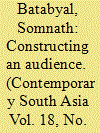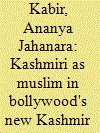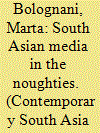|
|
|
Sort Order |
|
|
|
Items / Page
|
|
|
|
|
|
|
| Srl | Item |
| 1 |
ID:
104002


|
|
|
|
|
| Publication |
2010.
|
| Summary/Abstract |
This paper is an ethnographic exploration of two television news channels in India, Star News in Hindi and Star Ananda in Bengali, part of Rupert Murdoch's burgeoning media empire in the country. It seeks to answer a couple of basic questions: in the world of private television news, who are the news producers and who is their audience? Through these questions, the paper tries to understand some of the fundamentals of news business; the intricate links that exist between television ratings, target audience groups, the journalist's news sense and content. It examines corporate policies in television organisations, which in pursuit of advertising revenue not only curtail editorial independence, but editorial imagination. I claim that despite the proliferation of news channels across the country, the economics of the television industry enforces a unitary vision of an affluent nation; an India articulated by the privileged for themselves.
|
|
|
|
|
|
|
|
|
|
|
|
|
|
|
|
| 2 |
ID:
104005


|
|
|
|
|
| Publication |
2010.
|
| Summary/Abstract |
In our research with young Bangladeshis, we have been repeatedly struck by the popularity of television, DVD and Internet material that offers a modernist, quasi-scientific defence of Islamic knowledge against both 'western' scientific criticisms and US fundamentalist Christians. The South Indian doctor Zakir Naik's programmes, broadcast on his own television channel (Peace TV) and also available widely on DVD, are very popular, and admired for their 'logical' and apparently even-handed approach. His Islamic Research Foundation propagates his and similar material on the Web. The Turkish scholar 'Harun Yahya' (Adnan Oktar) 's diatribes against Darwinism and other western scientific evils are widely available on the Internet as text, audio and video, and often referred to. Full-on conspiracy theory material such as 'The Arrivals' series of online videos also finds a ready audience. We ask why these apparently implausible attacks on western knowledge carry conviction among young Muslims, many of them students studying for western-style university degrees in Bangladesh or the United Kingdom. We also ask to what degree the views of men such as Naik and Yahya might provide the basis of an alternative modernity, and what the implications of their wide popularity might be in the political arena.
|
|
|
|
|
|
|
|
|
|
|
|
|
|
|
|
| 3 |
ID:
104001


|
|
|
|
|
| Publication |
2010.
|
| Summary/Abstract |
This article examines the depiction of the Kashmiri protagonist in three popular Indian films, Roja (1992), Mission Kashmir (2000), and … Yahaan (2005), in order to argue for a new emphasis, cumulatively evident through these films, on the Kashmiri as Muslim in the history of Bollywood's long engagement with the Valley of Kashmir. In analysing closely the visual, narrative, cinematic and affective aspects of this development, and in contextualising it against global and local politics of Islam, the article aims to contribute to a better understanding of how Kashmir, and Islam, while topics with separate discursive genealogies within Bollywood, have converged decisively at a certain historical juncture so as to open up new possibilities for the ideological co-optation of the Kashmir conflict, and the place of Muslims in India, by the popular cinematic apparatus.
|
|
|
|
|
|
|
|
|
|
|
|
|
|
|
|
| 4 |
ID:
104000


|
|
|
|
|
| Publication |
2010.
|
| Summary/Abstract |
This introductory note identifies the scope of this special issue as a challenge to predominantly technology-based analysis of media in South Asia. By exploring the ways in which specific power structures, multiple cultural and social milieus, and the flourishing of technological possibilities play out in the different case studies, these authors reject the view of media as an all-encompassing power by highlighting different cases where a disjuncture between technological progress and social or political change takes place. The textual and ethnographic studies of this volume show that media groups can only be successful in participating in social change if the audiences are already responsive or 'culturally intimate' with their contents. We are in favour, hence, of a social analysis that accounts for technological potential (mostly borrowed by the 'centre' of economic and technological global power) and its localised use.
|
|
|
|
|
|
|
|
|
|
|
|
|
|
|
|
| 5 |
ID:
104006


|
|
|
|
|
| Publication |
2010.
|
| Summary/Abstract |
This research note begins by pointing to the forms of geographical and political enclosure that have resulted from the current Sri Lankan government's effective regulation of parts of the national media, as well as its mediation of knowledge produced about Sri Lanka more generally. It argues that a rather draconian and unbreachable geography of inside and outside is instantiated by the political regime's insularizing regulation of the country's media(tion). The research note then points to new virtual spaces in the Sri Lankan context that are reconfiguring this sticky geography of inside and outside. In particular, it argues that Sri Lanka's burgeoning blogosphere and online citizen journalism provide new, participatory spaces for dissent, debate and the free flow of information that have much potential to assist in the production of a more robust and critical civil society. The emergence of these spaces points to the importance of geography and spatiality in manufacturing an effective critical politics in contemporary Sri Lanka.
|
|
|
|
|
|
|
|
|
|
|
|
|
|
|
|
| 6 |
ID:
104004


|
|
|
|
|
| Publication |
2010.
|
| Summary/Abstract |
Among the urban Pakistani youth, SMS texts have become of critical importance in mediating religious and aesthetic sensations in unexpected domains of everyday life. Although grounded in a distinct valuation of the moral bearing of language upon individuals, texting religious messages is not simply a new way of pursuing a 'traditional' form of sociality. Texting reactivates religious texts with an unprecedented immediacy, and facilitates the expression of playfulness and visceral matters, empathy, humour and admonitions to embrace religious righteousness. This entanglement of discordant aspirations leads to a greater visibility of Islam, but does not suggest the emergence of a deliberative space. For this mediation is also about instigating affective responses that can unsettle the moral consistency advocated in religious SMSs. I argue that this ludic gesture orientated towards the restoration of Islamic morality introduces immediacy and circulation as critical parameters in the appreciation of authentic and effectual Islamic knowledge.
|
|
|
|
|
|
|
|
|
|
|
|
|
|
|
|
| 7 |
ID:
104003


|
|
|
|
|
| Publication |
2010.
|
| Summary/Abstract |
On 3rd November 2007 General Parvez Musharraf imposed a State of Emergency on Pakistan. During the State of Emergency the judiciary was turned upside down, the media selectively censored and many lawyers and human rights activists were arrested. While the lower classes remained relatively silent and carried on with their daily routines, an unprecedented movement against Musharraf, but more so pro-democracy and pro-judiciary, swept the country. This paper analyses the interrelation between the political concerns of a specific (upper-middle class) class subculture, the extraordinary means of communication available to them and the development of the protest. The paper argues that the way in which the protest was organised and negotiated was profoundly rooted in class divisions affecting consumption and production in the field of new media, and that where convergence between new and old media occurred, this was not enough to significantly involve other classes. The paper concludes by highlighting how meta-mediatic outputs and productions aimed primarily at a foreign audience nevertheless had an important role in changing the nature of the Pakistani public sphere, although it confutes theories that new media can produce social change at a great speed. The data was collected through participant observation, monitoring of internet blogs and videos, collection of articles in the English press, and interviews with prominent figures in the protest.
|
|
|
|
|
|
|
|
|
|
|
|
|
|
|
|
|
|
|
|
|